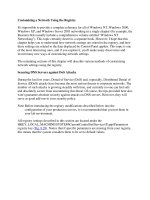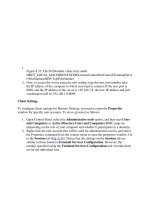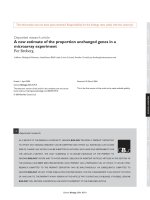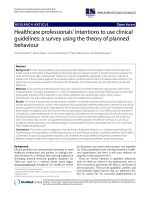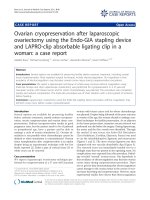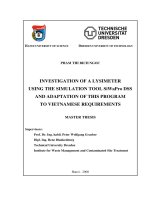INVESTIGATION OF a LYSIMETER USING THE SIMULATION TOOL siwapro DSS AND ADAPTATION OF THIS PROGRAM TO VIETNAMESE REQUIREMENTS
Bạn đang xem bản rút gọn của tài liệu. Xem và tải ngay bản đầy đủ của tài liệu tại đây (1.61 MB, 72 trang )
1
HANOI UNIVERSITY OF SCIENCE
TECHNICAL UNIVERSITAT DRESDEN
PHAM THI BICH NGOC
INVESTIGATION OF A LYSIMETER
USING THE SIMULATION TOOL SiWaPro
DSS AND ADAPTATION OF THIS PROGRAM
TO VIETNAMESE REQUIREMENTS
MASTER THESIS
Tutor:
Prof. Dr. Ing. habil Peter Wolfgang Graeber
Dipl. Ing. Rene Blankenburg
Technical University Dresden
Institute of Waste Management and Contaiminated Site Treatment
HANOI – VIETNAM, DECEMBER 2008
2
TECHNISCHE UNIVERSITÄT DRESDEN
INSTITUTE OF WASTE MANAGEMENT AND CONTAMINATED SITE TREATMENT
Master Thesis
Pollutant mixtures: Investigation of resulting changes in the
single compounds water solubility
Supervisor:
Dipl.-Ing. Dipl.-Ing. Jens Fahl
TU Dresden,
Institute for Waste Management and Contaminated Site Treatment
Hanoi, 2008.
3
Acknowledgment
First of all, I would like to express my thankfulness for Jens Fahl, my supervisor for your
knowledge and enthusiasm. Without your encouragement and advice I can not complete
this work. I also gratefully acknowledge Dr. Axel Fischer for all you have done for me.
Special thanks for Marene, you are very kind and patient for me. Thanks for Stefan,
Claudia, I'm very grateful for your support.
I would like to thank Prof. Dr. Bilitewski, Prof. Dr. Nguyen Thi Diem Trang and Assc.
Prof. Dr. Bui Duy Cam for great effort to establish and develop this program.
I also would like express my gratitude to the following organizations for supporting me
throughout the course
- The Committee on Overseas Training Project- Ministry of Education and Training of
Vietnam
- Hanoi University of Science - Vietnam National University
- Institute for Waste Management and Contaminated Site Treatment – TU Dresden
- German Academic Exchange Service (DAAD)
Warmly thanks to Mai, Christian, Hai Minh for your help. Thanks to all my colleagues
who shared a good time with me. Finally, thanks to my family, my parent, my mother in
law, my husband and my little son who always along with me, encourage and share
difficulties and pleasure as well.
Hanoi, 10th December, 2008.
Vu Huyen Phuong
4
Table of contents
Acknowledgment ............................................................................................................. 3
Table of contents ............................................................................................................. 4
Abbreviations .................................................................................................................. 6
Figures and pictures ....................................................................................................... 7
Tables ............................................................................................................................... 8
Summary ........................................................................................................................ 10
1.
INTRODUCTION................................................................................................. 11
1.1
Some important definition related to solubility ............................................... 16
1.2
Factors influencing solubility .......................................................................... 17
1.2.1
Temperature effects: ................................................................................. 17
1.2.2
Pressure effects ......................................................................................... 19
1.2.3
Salting out effect ....................................................................................... 20
1.2.4
Cosolvent effects ....................................................................................... 20
1.3
Estimation of solubility ..................................................................................... 21
2 MATERIALS AND METHODS ......................................................................... 27
2.1
Materials ........................................................................................................... 27
2.2
Experimental procedure .................................................................................... 30
2.3
Analyzing method ............................................................................................. 33
2.3.1
Ethylbenzene and Toluene ........................................................................ 33
2.3.2
Anthracene and Naphthalene .................................................................... 33
2.3.3
Phenol ....................................................................................................... 34
2.3.4
Tetradecane ............................................................................................... 34
2.4
Assessment of experimental data ...................................................................... 37
3. RESULTS AND DISCUSSIONS ............................................................................. 39
3.1.
Preliminary experiments ................................................................................... 39
3.2.
Water solubility of studied organic compounds in pure form .......................... 45
3.2.1.
Solubility of Ethylbenzene in water .......................................................... 46
3.2.2.
Solubility of Phenol in water .................................................................... 50
3.2.3.
Solubility of Anthracene and Naphthalene in water ................................. 52
3.3.
Water solubility of studied organic compound mixtures .................................. 55
3.3.1.
Mixture of Ethylbenzene and Toluene ...................................................... 56
3.3.2.
Mixture of Ethylbenzene and Phenol ........................................................ 58
3.3.3.
Ethylbenzene – Anthracene – Naphthalene Mixture ................................ 60
3.3.4.
Ethylbenzene – Toluene - Anthracene – Naphthalene Mixture ............... 61
5
4.
3.3.5.
Phenol - Tetradecane Mixture; Naphthalene – Tetradecane Mixture and
Special Mixture ......................................................................................................... 64
PROSPECT ........................................................................................................... 66
5.
CONCLUSIONS ................................................................................................... 67
6.
References .............................................................................................................. 68
7.
Statement under oath ........................................................................................... 71
8.
Appendix ................................................................................................................ 72
6
Abbreviations
HOC:
Hydrophobic Organic Chemical
PMOS:
Partially Miscible Organic Solvent.
IUPAC:
International Union for Pure and Applied Chemistry
VOC:
Volatile Organic Compound
PAH:
Polycyclic Aromatic Hydrocarbon
UNIFAC:
Universal Quasi Chemical Functional Group Activity Coefficient
BTEX:
Benzene – Toluene – Ethylbenzene – Xylene
GC:
Gas Chromatograph
HPLC:
High Performance Liquid Chromatograph
7
Figures and pictures
Figure 1: Ranges in water solubility of some organic compound classes
Figure 2: Water solubility as a function of temperature
Figure 3: Experimental and predicted value for mixture ethanol –
cyclohexane
Figure 4: Ethylbenzene concentrations in aqueous phase of three time
sampling
Figure 5: Anthracene concentrations in aqueous phase of two time
sampling
Figure 6: Comparison of water solubility of Ethylbenzene in different
temperature
Figure 7: Comparison of water solubility of Toluene in different
temperature
Figure 8: Comparison of water solubility of Phenol in different
temperature
Figure 9: Solubility of Anthracene in water of selected data
10
18
25
Picture 1: Glass vial 20ml with special silicone septum
Picture 2: Glass vessel 100ml with special rubber cap
Picture 3: Glass vessel 500ml with special rubber cap
Picture 4: Samples is kept at 20oC
Picture 5: Store samples in room 5oC
Picture 6: Store samples in room 10oC
Picture 7: Taking sample by microliter syringe 50μl
Picture 8: Taking sample by syringe 2ml
Picture 9: Preparation sample for GC/headspace
Picture 10: Preparation sample for HPLC
Picture 11: GC/headspace
Picture 12: GC System
Picture 13: Spectrometer
Picture 14: HPLC System
Picture 15: Experiment to determine stirring needed or not to get
maximum solubility
29
29
30
31
32
32
32
32
36
36
36
36
36
36
41
42
43
47
50
51
53
8
Tables
Table 1: Chemical/physical properties of selected substances in this work
12
Table 2: Difference of solubility in different temperature
19
Table 3: Effect of pressure on the solubility of Xylene
19
Table 4: Purity of studied substances
28
Table 5: Concentration of Ethylbenzene and Anthracene at different times
39
Table 6: Ethylbenzene concentrations (mg/l) in stirring and non-stirring condition
41
Table 7: Anthracene concentrations (μg/l) in stirring and non-stirring condition
41
Table 8: Solubility of Ethylbenzene at different temperature (mg/l)
46
Table 9: Comparison of experimental data and literature data of Ethylbenzene
46
Table 10: Solubility of Toluene at different temperature (mg/l)
48
Table 11: Comparison of experimental data and literature data of Toluene
48
Table 12: Solubility of Phenol at different temperature (mg/l)
50
Table 13: Average value of phenol solubility in water
51
Table 14: Solubility of Naphthalene and Anthracene at 20oC
52
o
Table 15: Comparison of experimental data and literature data of Antharacene at 20 C
52
Table 14: Comparison between experimental data and literature data of Naphthalene at
54
20oC
Table 15: Aqueous concentration of Ethylbenzene and Toluene in their mixture at
56
20oC
Table 16: Aqueous concentration of Ethylbenzene and Toluene in their mixture at 5oC
57
Table 17: Comparison of experimental and calculated solubility of Ethylbezene and
58
Toluene at 20oC
Table 18: Aqueous concentration of Ethylbenzene and Phenol in their mixture at 20oC
59
Table 19: Aqueous concentration of Ethylbenzene and Phenol in their mixture at 5oC
59
Table 20: Aqueous concentration of Ethylbenzene – Anthracene – Naphthalene in the
60
o
mixture at 20 C
Table 21: Aqueous concentration of Ethylbenzene – Anthracene – Naphthalene in the
mixture at 5oC
60
9
Table 22: Accuracy of experimental values for components in the mixture
61
Ethylbenzene – Anthracene – Naphthalene
Table 23: Aqueous concentration of Ethylbenzene – Toluene - Anthracene –
62
o
Naphthalene in the mixture at 20 C
Table 24: Aqueous concentration of Ethylbenzene – Toluene - Anthracene –
62
Naphthalene in the mixture at 5oC
Table 25: Accuracy of experimental values of component of mixture Ethylbenzene –
63
Anthracene – Naphthalene
Table 26: Comparison of experimental and calculated solubility of each component in
63
o
mixture Ethylbenzene – Toluene - Anthracene – Naphthalene at 5 C
Table 27: Aqueous concentration of components of the mixture Phenol - Tetradecane
65
and Naphthalene and Tetradecane at 20oC
Table 28: Aqueous concentration of components in Special Mixture at 5oC and 20oC
65
10
Summary
The study of water solubility of contaminants has become important in the practice of
contaminated site management, assessment and remediation. At the contaminated site it
is not often found only one contaminant, many other substances can mix each other to
form a contaminant mixture.
In fact, in one field site we have a product phase which contaminated the soil. This phase
consist of mineral oil, BTEX-compounds, PAH-compounds and phenol. If we use the
solubility of these substances in literature, we would expect the water solubility for
benzene with values of 1.7 g/l, for example. But on the site we only find benzene
concentrations of 50 mg/l. That’s the reason to investigate which affect the water
solubility of each component in the mixture.
This work presents briefly theory of solubility, researches relating to water solubility of
single compound and mixture, how to calculate water solubility of components in a
mixture.
This work determined the water solubility of six substances including Ethylbenzene,
Toluene, Anthracene, Naphthalene, Phenol and Tetradacane at temperatures 5-10-20oC.
Water solubility of mixtures of these substances was observed at temperatures 5 and
20oC. Solubility of single compounds compared to those in literature for determining
accurate and precise received data. Water solubility of single compounds and mixture
also compared them each other. The difference between these data was explained
following solubility’s theory. Water solubility of some mixtures was calculated and
compared to experimental value. Behaviours of components in the mixture also predict
from experimental data.
11
1. INTRODUCTION
Water solubility is one of the most important properties of compounds. Water solubility
is defined as the concentration of a compound dissolved in water when that water is both
in contact and at equilibrium with the pure chemical. Solubility represents an equilibrium
distribution of a solute between water and the solute phase [1]. It is found various range
of water solubility from hundred grams to only few ppb for organic substances. Some
compounds are completely soluble in water such as methanol. Figure 1 shows range in
water solubility of some organic compound classes in mol/liter.
Figure 1: Ranges in water solubility of some organic compound classes [2]
12
Water solubility of almost substances was studied and listed in handbooks. However, in
some cases, solubility of organic compounds in the pure form has not been determined, in
references it is mentioned as “not soluble”, “insoluble”, “miscible”, “slightly soluble” or
“moderate soluble”. Water solubility of some substances studied in this work is given as
an example of this fact, and is shown on Table 1.
Thus, water solubility is very important factor for controlling manufacture process, a
valuable data in pharmaceutical study field and for controlling fate and transport of
contaminants. If a highly soluble substance is quickly distributed, and diluted, an
insoluble substance is more likely to adsorb on solids, or accumulate in biota. So, water
solubility indicates the tendency of a chemical to be removed from soil to reach the
surface water or ground water, to precipitate at the surface soil [2].
Present techniques for assessing or modelling the contaminant transport to environmental
components typically rely on data such as solubility and the octanol-water partition
coefficient for the calculation of bioconcentration factors, sediment adsorption
coefficients, toxicity, and biodegradation rates.
Simple example, if the amount of seepage water is known, the substance mass in the soil
and their water solubility, mass of the contaminating substance which will be transported
over the time to the groundwater can be calculated. And the lifetime of this soil
contamination can also estimated.
13
Table 1: Chemical/physical properties of selected substances in this work
Ethylbenzene(1)
Toluene (1)
Phenol (1)
Anthracene (1)
Naphthalene (1)
Tetradecane (2)
C8H10 / C6H5C2H5
106.2
C6H5CH3 /
C7H8
92.
C6H6O /
C6H5OH
94.1
C14H10 /
(C6H4CH)2
178.2
C10H8
C14H30
128.18
198.4
Boiling point
136°C
111°C
182°C
342°C
218°C
Melting point
-95°C
-95°C
43°C
218°C
80°C
0.9
0.87
1.06
1.25-1.28
1.16 g/cm³
0.763
0.015
(g/100 ml at
20°C)
0.9 (kPa)
None
(at 20°C)
Moderate
(at 20°C)
None
(at 25oC)
insoluble
3.8 (kPa)
47 (Pa)
0.00013
(g/100 ml at
20oC)
0.08 (Pa)
3.2
2.69
1.46
4.5
3.3
Substance
Formular
Molecular mass
Relative density
(water = 1)
Solubility in
water
Vapour pressure,
at 20°C
Octanol/water
partition
coefficient as log
Pow
11 (Pa)
(1)
Data is cited from Physical Properties of International Chemical Safety Card of
Ethylbenzene, Toluene, Phenol, Anthracene and Naphthalene [3]
(2)
Data is cited from Material Safety Data Sheet of N-Tetradecane [4]
In fact, a substance is rarely found in the pure form in the nature, it is usually mixed with
other substances and modified different from its origin. Especially, contaminated sites
where substances have been become intermixed through careless dumping procedures or
through failure to segregate waste steam [5]. In general, behavior of mixture of these
substances is very complicated. If the mixture comes in contact with aqueous phase and
form a solution, water solubility value of the single compounds from this mixture will not
be the same like the value which listed in literature. Because these values are typically
validate only for the solution of a single substance in pure water under laboratory
conditions.
Water solubility in both synthetic and environmental mixtures has been carrying out by
scientists over the world. Relating to the selected compounds for this study, some
13
researches have been found and used in this as a literature source. Sujit Banerjee spent
many years for researching on water solubility of components in liquid-liquid mixture,
liquid-solid mixture and solid- solid mixture. Many his works have been publicized. He
investigated solubility of many organic compounds and organic mixtures as well [6]. For
example, solubility at 25oC of several chlorobenzenes, some mixtures of chlorobenzene,
mixture of benzyl alcohol with several chlorobenzenes, mixture benzyl alcohol and
toluene, ethyl acetate were determined. This work found that mixture of hydrophobic
liquid is near ideal in the organic phase, in the aqueous phase the activity coefficient of a
component was unaffected by the presence of cosolute. Increasing hydrophobicity of the
solutes led to deviations from ideality in the organic phase. For the mixtures of solids
which did not interact, the components tended to be behave independently of one other,
and their solubility ware approximately additive.
Clayton McAuliffe [7] determined the solubility in water at room temperature of 65
hydrocarbons including Paraffin and Branched-Chain Paraffin Hydrocarbons, Olefin
Hydrocarbons, Acetylene Hydrocarbons, Cycloparaffin, Cycloolefin, and Aromatic
Hydrocarbons by using a gas-liquid partition chromatographic technique. This work
found branching increases water solubility for paraffin, olefin, and acetylene
hydrocarbons, but not for cycloparaffin, cycloolefin, and aromatic hydrocarbons. For a
given carbon number, ring formation increases water solubility. Double bond addition to
the molecule, ring or chain, increases water solubility. The addition of a second and third
double bond to a hydrocarbon of given carbon number proportionately increases water
solubility. A triple bond in a chain molecule increases water solubility to a greater extent
than two double bonds.
Coyle, Harmon and Suffet [8] measured solubility of hydrophobic organic chemicals
(HOC), including Naphthalene, Biphenyl, PCB-47, PCB-153, in water saturated with
partially miscible organic solvents (PMOS), including methylene chloride and
chloroform. Generator Column Technique was used for solubility measurement in mixed
solution. The author concluded that solubility of Naphthalene was not much impacted by
the solvents, while that’s of Biphenyl decreased slightly with increasing solvent’s
14
concentration. In aqueous phase, chloride and chloroform, PCB-47 concentration in
aqueous phase were reduced about 25% and 15%, respectively, of its aqueous solubility.
The solubility depression increased with increasing chemical hydrophobic of both HOC
and solvents. Through the research results, the authors also explain behaviors of organic
mixture and contaminant transport in soil and groundwater. The association of the
solvents like methylene chloride and choroform with HOC phase will retard the
transportations of this relatively mobile solute through sediments contaminated with
HOC. And the presence of nearly saturated solution of PMOS will reduce the apparent
solubility and therefore the mobility of the HOC.
Aqueous solubility of PAH was determined by Donald Mackay and Wan Ying Shiu
(1977). The solubility of 32 PAHs has been measured in water at 25oC. The results of ten
of the compounds compare satisfactorily with literature values. Aqueous solubility can
then be calculated directly for hydrocarbons which are liquid at 25oC [9].
Ghanima K. Al-Sharrah, Sami H. Ali and Mohamed A. Fahim (2001) measured solubility
of anthracene in two mixed solvents toluene and 2-propanol and toluene and heptane is
studied in the temperature range 20– 50oC. The comparison between experimental and
predicted solubility by two models - UNIQUAC and modified UNIFAC is quite
reasonable with an average prediction coefficient between 0.995 and 0.971 [10]. Other
work of this group author (2005) investigated solubility of pyrene and phenanthrene in
toluene solvent mixture of iso-octane and heptane over a temperature range from 2050oC. The experimental solubility data were used to predict the interaction parameters
for seven different solid–liquid equilibrium models [11].
The solubility of several n-paraffins (from Dodecane C12 to Hexadecane C26) in both
distilled water and seawater has been determined by Chris Sutton and John A. Calder
(1974). The results shown these n-paraffins have very low water solubility in ppb range.
But n-paraffin is less soluble in seawater than in distilled water. This work also indicates
importance of salting out effect on water solubility. This fact explains transportation and
fate of paraffins in seawater and estuaries area [12].
15
The solubility of normal paraffins from methane to decane (C10) has been investigated
by Mc.Auliffe (1969). This work found that the solubility at 25oC of the normal alkanes
decrease with increasing carbon number (solubility of C9 is 220 ppb and C10 is 52 ppb)
[13].
An important database on solubility - IUPAC Solubility Data Series, containing solubility
originally published in International Union for Pure and Applied Chemistry is now
available online. There are over 67,500 solubility measurements. There are about 1800
chemical substances in the database and 5200 systems, of which 473 have been critically
evaluated. Solubility and liquid-liquid equilibrium of binary, ternary and quaternary
systems are presented. Typical solvents and solutes include water, sea water, heavy
water, inorganic compounds, and a variety of organic compounds such as hydrocarbons,
halogenated hydrocarbons, alcohols, acids, esters and nitrogen compounds. For many
systems, sufficient data were available to allow critical evaluation. Data are expressed as
mass
and
mole
fractions
as
well
as
the
originally
reported
units
[14].
16
1.1 Some important definition related to solubility
Solubility is referred as the ability for a given substance, call the solute (solute can be a
solid, liquid or gas), to dissolve in a solvent. It is measured in terms of the maximum
amount of solute dissolved in a solvent at equilibrium [3].
A solution is a liquid or solid phase containing more than one substance, when for
convenience one of the substances, which is called the solvent, and may itself be a
mixture, is treated differently than the other substances, which are called solutes. If the
sum of the mole fractions of the solutes is small compared to unity, the solution is called
a dilute solution [3].
A mixture is describes a gaseous, liquid or solid phase containing more than one
substance, where the substances are all treated in the same way [3].
Activity coefficient (γ) of a substance is defined as the chemical potential of its in liquid
or solid mixture. An activity coefficient is a factor used in thermodynamics to account
for deviations from ideal behavior in a mixture of chemical substances [15].
For pure compound dilute in water, activity coefficient of this solute in the solute phase is
unity. But in mixture many components interact within the mixture, had led to changes of
mixture’s solubility. In general, interaction takes place between solute in the organic
phase, rather than in the aqueous phase. Hydrophobic solutes tend to be diluted in the
aqueous phase to interact significantly each other. Liquid solute are usually mix each
other resulting to they are able to interact within the organic phase. Solid solutes tend not
to mix with other ones and they behave independently each other. In this case, mixture’s
solubility of solids is frequently the sum of the solubility of its components [1].
It is said that water solubility represents equilibrium of a solute between water and solute
phase. The following will discuss more details about type of solute and solute phase, the
way of solute and solute effects on solubility.
17
There are three type of solute including liquid solute, gaseous solute and solid solute. For
liquid solutes, the ideal solution tends to be formed if the solute and solvent molecules
are very similar in size and in the nature of their intermolecular interactions. Solutions of
n-heptane in hexane, toluene in benzene or carbon tetrabromide in carbon tetracholoride
are very nearly ideal. Other case, the solute and solvent molecules are similar polarity but
have great difference of molecule size, the solution of them is considered as an ideal
mixture.
For solid solute, it is necessary to account for the inhibitory effect of crystal structure
upon solubility. It is well known that the solubility of a crystalline solute in any solvent
depends on properties of the crystals which is given by the van’ Hoff equation.
Gaseous behavior is explained by Henry’s Law which says the solubility of a gas in a
liquid is proportional to the pressure of the gas.
1.2 FACTORS INFLUENCING SOLUBILITY
1.2.1 Temperature effects:
Aqueous solubility is a function of temperature. Increasing temperature reduces waterwater, water – solute and solute – solute interactions [1]. Figure 2 shows temperature
effects on solubility of some compounds.
For solid solutes, the effect of temperature is important. The solubility generally increases
with temperature, in the temperature range from about room temperature to 100°C.
About 95% solid solute obeys this rule of thumb. However, some of solid only have
solubility increase in a certain range of temperature [1]. The detail of this fact will be
discussed later. For most gaseous solutes, the water solubility decreases with increasing
temperature. That means as the temperature is raised gases usually become less soluble in
18
water. Many organic liquids exhibit minima in solubility at room temperature. In general,
solubility of solids is much more sensitive to temperature effect than liquids [1]
Figure 2: Water solubility as a function of temperature. [2]
Temperature effects on solubility can be different, depending on the temperature range.
Evidence of this fact is shown in Table 2. Solubility of some organic compounds only
slightly depends on temperature in certain range. Some of compounds have complex
behaviors, for example Benzene solubility decreases with increasing temperature below
~15°C, but increases with increasing temperature above ~20°C [2].
19
Table 2: Difference of solubility in different temperature [1]
Solute
Relative Solubility
mdichlorobenzene
Diethyl phthalate
10oC
20oC
1.00
0.77
1.20
1.00
0.84
0.87
1.00
0.97
1,1,2,2tetrachloroethane
Octachlorobiphenyl
Phenanthrene
1.00
Fluorene
4-nitrophenol
1.00
25oC
30oC
40oC
50oC
0.99
1.29
6.72
1.00
1.29
2.09
3.51
1.00
1.27
2.02
3.31
1.62
2.29
1.2.2 Pressure effects
For solid and liquid phase, the influence of pressure on solubility is typically weak and
usually neglected in practice. The effect of pressure on solubility is only important at
very high pressure.
Table 3: Effect of pressure on the solubility of Xylene [1]
Pressure (MPa)
Percent increase in solubility
o-xylene
m-xylene
p-xylene
0.1
1
1
1
50
7.7
7.3
8.6
100
13.2
10.5
8
150
12.5
10.4
200
10.2
8.1
250
5.6
5.8
300
2.4
350
-1.9
385
-5.4
20
In case of Xylene, solubility intensively influenced by pressure but only occurs at
extremely high pressure. The table shows the solubility increases significantly, reaches to
maximum point and then falls down.
1.2.3 Salting out effect
The aqueous solubility of different kinds of compounds such as proteins, volatile organic
compounds, gases, detergents, etc. decrease in the presence of inorganic salts, this is
called the salting-out effect. The solubility decrease is quantified by the classical
Setschenow equation, named a scientist [16].
(1)
where S0 is the solubility of the non-electrolyte (solute) in pure water,
S is the solubility in the presence of a salt,
γ is the activity coefficient of the non-electrolyte
KS (salt, solute) is the Setschenow constant
c is the salt concentration
The salting-out effect is known to be influenced by the polarity (dipole moment) of the
non-electrolyte. Substances more polar are salted out from a given salt solution to a
smaller degree.
1.2.4 Cosolvent effects
The effect on the water solubility of organic compounds of adding one or more
completely water-miscible organic cosolvents is defined as cosolvency [17].
The solubilization by co solvents can be expressed by the log-linear model
21
log S=log Sw+σf
where
(2)
S and Sw are the solubility in the co solvent–water mixture and water,
respectively
f the fraction of the co solvent.
σ the solubilization capacity and can be defined by the following equation
using the octanol–water partition coefficient (log Kow)
The log–linear model was demonstrated that a linear relationship exists between σ and
the logarithm of the solute's partition coefficient (log Kow) [18]. This explains how
strongly a solute is solubilized and how hydrophobic the compound is. In essence, the
more hydrophobic the solute, the more it will be solubilized by cosolvent addition.
1.3 Estimation of solubility
Estimation of solubility in water of organic compounds is not easy, especially for
mixtures of organics. In case of pure compound seem to be less complex. But in mixture
many components interact within the mixture, had led to changes of mixture’s solubility.
Some methods have been researched and developed for estimation of aqueous solubility
of mixture. According to Sujit Baneejee [1] calculated solubility for mixtures obeyed
these following equations. The different between experimental data and calculated data
was pointed out in some his work which will be discussed later.
When a hydrophobic liquid is equilibrated with water, its solubility is given by equation
(3)
χorg γorg
χaq =
_____________
γaq
(3)
22
χaq:
mole fraction of the compound in aqueous phase
χorg:
mole fraction of the compound in organic phase
γaq:
activity coefficient of the compound in aqueous phase
γorg:
activity coefficient of the compound in organic phase
If organic phase is pure form of the substance, χorg, γorg both approximate unity,
equation (3) reduce to equation (4)
1
χaq =
_______
(4)
γaq
If a mixture is constituted by organic components and water, water solubility of
component ith can be written as in equation (5)
(χi)org (γi)org
(χi)aq =
___________________
(5)
(γi)aq
The saturation concentration of this component can be expressed as a fraction of its
solubility in its pure form as shown in equation (6)
(χi)org (γi)org / (γip)aq
(χi)aq
_____________
(χip)aq
=
__________________________
(6)
(γi)aq
(χip)aq : solubility in water of the pure ith component
(γip)aq : activity coefficient of the pure ith component
(χi)org : mole fraction of itch component in organic phase
(γi)org : activity coefficient of ith component in organic phase
Equation (6) is more conveniently expressed as equation (7)
23
(χi)org (γi)org (γip)aq
Ci
__________
=
__________________________
Si
Where
(7)
(γi)aq
Ci: equilibrium molar concentration of the itch component in the mixture
Si: water solubility of itch component in its pure form
If interaction in the aqueous phase is small and (γi)aq = (γip)aq, equation (7) reduces to
equation (8):
Ci
__________
= (χi)org (γi)org (8)
Si
If the mixture is ideal, (γi)org = 1 and equation (8)simplified to equation (9)
Ci
__________
= (χi)org (9)
Si
Equation (9) is the simplest and applied for near ideal mixture
Equation (8) corrects for activity coefficient in the organic phase
Equation (7) corrects for activity coefficient in both organic and aqueous phase
Here, activity coefficient (γ) is calculated by UNIFAC (Universal Quasi Chemical
Functional Group Activity Coefficients) methods which developed by Prausnitz and coworkers [15]. This method is well-known as a Group Contribution Method has been used
to estimate the appropriate activity coefficients for mixtures. In group contribution
methods, it is assumed that the mixture does not consist of molecules, but of functional
groups. Activity coefficients are calculated from constants reflecting the sizes and surface
areas of individual functional groups, and parameters representing energetic interactions
between groups. Size and area parameters for groups were evaluated from purecomponent, molecular structure data. Group interaction parameters were evaluated from
24
phase equilibrium data for mixtures containing paraffins, olefins, aromatic hydrocarbons,
water, alcohol, ketones, amines, esters, ethers, aldehydes, chlorides, nitriles, and other
organic liquids [15]. From activity coefficient of the functional groups of both solute and
solvent in the mixture, they are reassembled to obtain the activity coefficient of the
mixture. This method has been successful for predict phase equilibrium, for estimating
pure-component properties such as liquid densities, heat capacities, and critical
constants...[19]. This method was applied for calculation of activity coefficients in a large
number of binary and multicomponent mixtures can be estimated with good accuracy
[20]
However, UNIFAC method is an approximation and has some weaknesses such as poor
results for activity coefficients at infinite dilution or excess enthalpies and systems with
compounds very different in size. The reason is contribution of a group in one molecule
is not necessarily the same as that in other. Furthermore no quantitative information about
the temperature dependence was used. So, modified UNIFAC method has been
developed.
The main differences compared to original UNIFAC are:
• an empirically modified combinatorial part is introduced (In the UNIFAC method, the
activity coefficients are calculated from a combinatorial and a residual part. Whereas the
combinatorial part takes into account the size and form of the molecule, the residual part
considers the enthalpic interactions).
• temperature-dependent group interaction parameters are used; and
• additional main groups (e.g., for cyclic alkanes, formic acid, etc.) were added [20].
Comparison of experimental and predicted value by UNIFAC and modified UNIFAC
method is described in Table 4.
